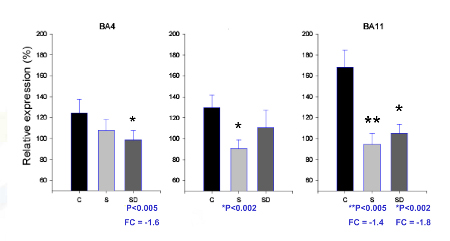Ocimum Biosolutions offers a full range of services from experimental designing to statistical analysis of quantitative real-time PCR data. Quantitative real-time polymerase chain reaction (qRT-PCR) technology is routinely used for a variety of applications such as expression analysis of candidate genes, validation of microarray, gene copy number determination and target detection with Taqman® probes or SYBR green. Quantitative realtime PCR assays are characterized by a wide dynamic range of quantification, high technical sensitivity, high precision, high throughput, lower turn-around-times and decreased costs. Key features of our qRT-PCR services include the following:
- Technical support for experimental design based on your need and criteria.
- Sample preparation such as RNA/DNA extraction, purification and QC.
- Design of high-performance RT-PCR assays: robust, sensitive and reproducible.
- Design of customized PCR primers/ probe based on TaqMan® assay or SYBR green.
- Reliable results generated by state-of-the-art bioinformatic analysis.
- Easy-to-understand report containing raw and normalized Ct Values in Excel format.
- Data analysis services include delta-delta Cts values and graphical presentation of genes with unique expression and differential regulation patterns
- All results including amplification graph of samples and the standard curve available in electronic and hard copy formats
Relative and Absolute Quantitation
The amount of template in a sample can be subjected to either relative or absolute quantitation. Relative quantitation describes changes in the amount of a target sequence by comparison to the signal from an endogenous or other reference control. Absolute quantitation states the exact number of nucleic acid targets present in the sample in relation to a specific unit, making it easier to compare data from different assays and laboratories. Ocimum has been using these methods in qRT-PCR in several application areas. Our application of relative quantitation for drug target identification is given in Figure 1.

Figure 1: Differential regulation and Gene Expression Patterns in Suicide and Suicide with Major Depression in different areas of post-mortem brain compared to control. Dr. J. M. H. ffrench-Mullen, Ph.D. Data on file, Gene Logic.
Key Applications and Services Using qRT-PCR
Ocimum has been working with key industries such as food and agriculture, molecular diagnostics, green tech companies and biopharmaceuticals while providing genomics research solutions, study design consulting or implementation of secure lab management solutions across widespread research locations. We understand the research needs across different industries. We have been routinely using qRT-PCR technology in several applications areas such as drug target and biomarker discovery, food authenticity, mutation detection, Clinical Microbiology, validation of array data and gene quantification. With our experience, we identify the following applications and services based on qRT-PCR technology.
| Clinical Microbiology | Biopharmaceuticals | Food and Agriculture | Molecular Diagnostics | |
| Sequencing | Development of pathogen subtype-specific assays | Determine safety of cell-derived biological compounds | Development of assays for target sequences of food borne pathogens and GM foods | Identify molecular markers for several disorders |
| Quantitative Gene Expression | Detection & quantification of various infectious agents
Understand functioning of normal tissues and elucidate pathogenesis of non-infectious diseases. |
Accurate quantitation of cytokine mRNA expression for measuring immunological responses
Identify potential contaminants during recombinant monoclonal antibody production |
Highly sensitive detection of fungal contamination in cereals
Detect human enteric viruses in foods |
Pre-natal diagnostics for identifying congenital disorders
Identification of specific genes, e.g., tumor suppressing genes |
| Genotyping | Predictive genetic testing and SNP identification
Comparative genomic investigation |
Study individual patient therapeutic responses at molecular level | Identify mutant alleles responsible for high oil content in seeds
Detect and monitor GMOs |
Determine genomic imbalance underlying most malignancies
Genotyping for mutation in genes involved in drug metabolism |
| Molecular Typing | Detection and quantification of chromosomal translocation to monitor minimal residual disease in clinical oncology | Conduct specialty testing such as ribotyping to characterize new drugs as required by US FDA | Accurate bacterial typing for epidemicological investigation of outbreaks through food poisoning | Construct a gene structure for cancer and rare disorders |
Sample Submission and Concentration Details
For Gene Expression: Range of 50-150 ng/ reaction; input RNA 1.6 – 4.8 ug
For SNP Genotyping: Range of 50-150 ng/ reaction; input DNA 1.6 – 4.8 ug
